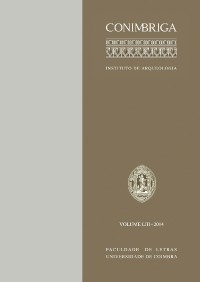Please use this identifier to cite or link to this item:
https://hdl.handle.net/10316.2/38796| DC Field | Value | Language |
|---|---|---|
| dc.contributor.author | Ribeiro, José Cardim | - |
| dc.date.accessioned | 2016-03-16T09:42:31Z | |
| dc.date.accessioned | 2020-09-22T20:52:52Z | - |
| dc.date.available | 2016-03-16T09:42:31Z | |
| dc.date.available | 2020-09-22T20:52:52Z | - |
| dc.date.issued | 2014 | - |
| dc.identifier.issn | 1647-8657 (digital) | - |
| dc.identifier.issn | 0084-9189 | - |
| dc.identifier.uri | https://hdl.handle.net/10316.2/38796 | - |
| dc.description.abstract | O texto lusitano de Cabeço das Fráguas evidencia, como opção compositiva claramente propositada, uma simetria formal entre as duas séries de elementos expressos, as oferendas animais e as divindades contempladas. Supondo os teónimos em dativo, a interpretação tradicional desta epígrafe previa pois a existência de dativos singulares em -a da 1ª declinação no contexto linguístico em análise. Mas este axioma baseia-se em indícios pouco seguros, tendo sido recusado por Untermann e outros que, porém, adiantaram alternativas também elas difíceis de aceitar. Uma solução conciliatória que entretanto ensaiámos veio igualmente a revelar- se infundada. Agora, revendo com atenção as características internas da inscrição e as especificidades do santuário, propomos uma alternativa radicalmente diversa, entendendo o texto das Fráguas como uma invocatio e considerando assim necessariamente os teónimos expressos, todos eles, em vocativo. | por |
| dc.description.abstract | The Lusitanian text of Cabeço das Fráguas follows an evident and clearly intentional symmetry between the two series of declared elements: the animal offerings and the receiving deities. Assuming the theonyms to be in the dative case, the traditional interpretation of this epigraph called for the existence of singular datives in -a of the first declension in this linguistic context. But this axiom is based on fragile evidences and was refuted by Untermann and others who, however, offered alternatives that lacked solidity themselves. An attempted compromise by the author of the present paper later proved to be likewise erroneous. Now, reviewing the internal features of the text and the specificities of the sanctuary, a radically different proposition is presented, approaching the epigraph of Fráguas as an invocatio and considering the theonyms to be necessarily written, without exception, in the vocative case. | eng |
| dc.language.iso | por | - |
| dc.publisher | Faculdade de Letras da Universidade de Coimbra | - |
| dc.rights | open access | - |
| dc.subject | Lusitanian | eng |
| dc.subject | declensions | eng |
| dc.subject | Invocatio | eng |
| dc.subject | voc./dat. ac./abl. | eng |
| dc.subject | Lusitano | por |
| dc.subject | declinações | por |
| dc.subject | invocatio | por |
| dc.subject | voc./dat. ac./ abl. | por |
| dc.title | “Damos-te esta ovelha, ó Trebopala!”: a invocatio lusitana de Cabeço das Fráguas | por |
| dc.title.alternative | “We give you this lamb, o Trebopala!”: the lusitanian invocatio of Cabeço das Fráguas (Portugal) | por |
| dc.type | article | - |
| uc.publication.collection | Conimbriga vol. 53 | - |
| uc.publication.firstPage | 99 | - |
| uc.publication.lastPage | 144 | - |
| uc.publication.location | Coimbra | - |
| uc.publication.journalTitle | Conimbriga: Revista de Arqueologia | - |
| uc.publication.volume | 53 | por |
| dc.identifier.doi | 10.14195/1647-8657_53_4 | - |
| uc.publication.orderno | 4 | - |
| uc.publication.area | Artes e Humanidades | - |
| uc.publication.manifest | https://dl.uc.pt/json/iiif/10316.2/38796/234504/manifest?manifest=/json/iiif/10316.2/38796/234504/manifest | - |
| uc.publication.thumbnail | https://dl.uc.pt/retrieve/11493945 | - |
| item.fulltext | With Fulltext | - |
| item.grantfulltext | open | - |
| Appears in Collections: | Conimbriga | |
Files in This Item:
| File | Description | Size | Format | |
|---|---|---|---|---|
| damos_te_esta_ovelha_o_trebopala.pdf | 3.23 MB | Adobe PDF |  |
Items in DSpace are protected by copyright, with all rights reserved, unless otherwise indicated.
